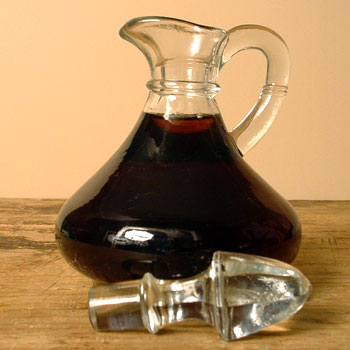
© Denzil Green
Malt vinegar is very popular in England and Canada. In many people’s minds, it is the best vinegar to put on fish & chips, and on chips (aka French fries) in general.
It is made from malted barley and grain that is mashed, then fermented, often in beech or birch barrels (or in any event, in casks containing pieces or shavings of those woods.)
Malt vinegar is too assertive in taste, and its coloration perhaps undesirable, for most mild vinaigrettes and sauces, but it is good for more robust applications such as marinades, pickling and chutneys.
Alan Davidson writes in the Penguin Companion to Food:
“It has a malty taste which may be disliked in salad dressing but appreciated in pickles. The natural faintly brown colour is usually darkened with caramel.” [1]Davidson, Alan. The Penguin Companion to Food. London: The Penguin Group, 2002. Page 994.
You can buy regular malt vinegar, which is brown, and distilled malt vinegar, which is clear. Some finer malt vinegars are now being brewed from single malt ales, for aficionados.
In Canada, there’s a legal definition for malt vinegar:
“Malt Vinegar shall be vinegar made from an infusion of malt undistilled prior to acetous fermentation, may contain other cereals or caramel, shall be dextro-rotatory, and shall contain, in 100 millilitres measured at a temperature of 20°C, not less than (a) 1.8 grams of solids, and (b) 0.2 gram of ash.” [2]Canada. Food and Drug Regulations Consolidation. C.R.C., c. 870. Division 19. 7. B.19.005. [S]. November 2014. Page 755.
Cooking Tips
Good for pickling, though, like cider vinegar, malt vinegar can darken light-coloured fruits & veg (unless you use distilled malt vinegar, which is clear).
If an English recipe calls for vinegar without specifying which type, it’s generally malt vinegar which is meant.
Literature & Lore
The writer Philip Morton Shand, the grandfather of Camilla Shand, wife to Charles, the Prince of Wales, wrote of malt vinegar:
‘The administering of this corrosive poison in any form whatever to an unsuspecting husband should be made a ground of divorce (without alimony).’ — Philip Morton Shand: A Book of Food. 1927.
Language Notes
English used to distinguish between vinegar made from wine (or vin, as they French say), and vinegar made from ale, as malt vinegar essentially was. Vinegar made from ale, which is to say malt vinegar, was called appropriately “alegar.”
The Oxford English Dictionary (3rd edition, 2012) defines alegar as: “Vinegar produced by the fermentation of ale; malt vinegar; a variety of this.
Alan Davidson, creator of the Penguin Companion to Food, sounded somewhat rueful about the loss of alegar as a name for malt vinegar. He felt it was more instructive about the origin of product:
“Malt vinegar used to be called alegar which is a more appropriate name as it is made from an unhopped type of beer.” [3]Davidson, Alan. The Penguin Companion to Food. London: The Penguin Group, 2002. Page 994.
References
| ↑1 | Davidson, Alan. The Penguin Companion to Food. London: The Penguin Group, 2002. Page 994. |
|---|---|
| ↑2 | Canada. Food and Drug Regulations Consolidation. C.R.C., c. 870. Division 19. 7. B.19.005. [S]. November 2014. Page 755. |
| ↑3 | Davidson, Alan. The Penguin Companion to Food. London: The Penguin Group, 2002. Page 994. |

